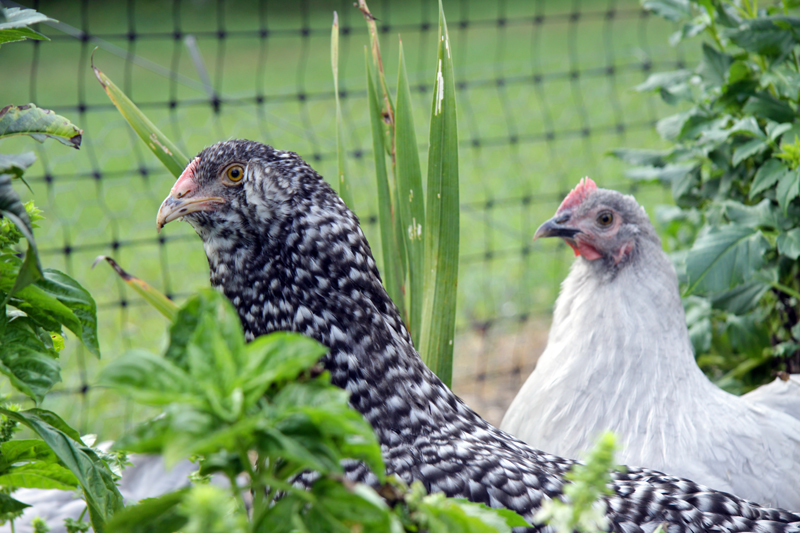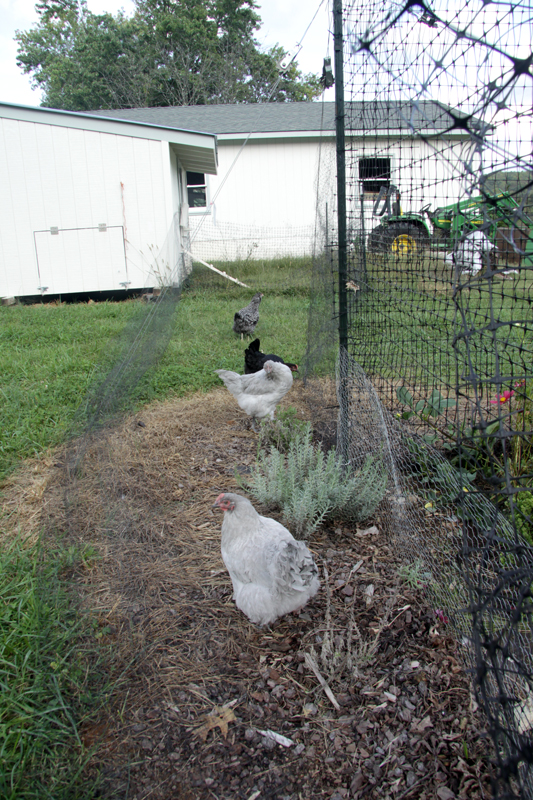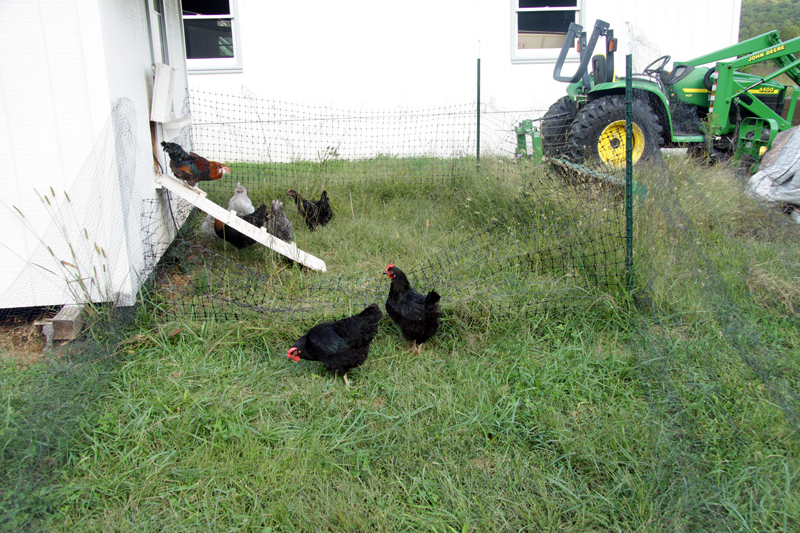I got up this morning and, all inspired by the things I learned from Patricia Foreman at the Mother Earth News Fair, decided to turn my chickens loose in my garden. There’s not too much in it now other than flowers and some last-ditch attempts at peas, beans and greens, and I figured that if the chickens took a shining to any of those it’d be no big loss. What I’m really after is pest control.
I caught each bird in the coop and plopped them in the garden, which when closed up in a fairly predator-proof arrangement. I wasn’t too worried about hawks as the dahlias and zinnias were tall and thick enough to provide good cover. Plus, I have a farm dog who took it upon himself to add “vigilantly defends against threats from the sky” to his long list of qualifications.
I checked on the birds throughout the day while I did one of my least-favorite farm chores, mulching around my trees. I wanted to make sure Lilac, who until now had been confined in a dog crate in the coop because she showed murderous tendencies toward Cora, was playing nicely. Everyone was fine all day.
Around five tonight I realized I’d better figure out how to get the birds back in their coop. Now, seven of my nine birds had never ventured further than their little redneck chicken run, and I couldn’t expect to just open the garden door and have them know how to find home. And chasing—and most likely losing—birds that had no ability to figure out how to get to bed before dark induced cringe-worth flashbacks to all the drama suffered with my guineas. I needed another plan.
So I did what any scrappy homesteader would do and looked around for something to repurpose for my needs. I found what I was looking for in a roll of netting that’s usually used to protect bushes from browsing deer. It’s much finer, and therefore easier to handle, than the heavy-duty plastic deer fencing I used around the garden and to make the chicken run. Plus, in addition to an almost new roll, I even had some already used netting balled up in a corner of the garage. I’d stuffed it there after I’d found it in the wellhouse, where it served as a death trap to what was by now a well-dessicated black snake. It’s been long enough that my memory of cutting that rotten snake out of the netting has faded, so I grabbed that piece as well.
A few clothespins later and I’d fashioned a corridor from the garden door into the chicken run. I opened the netting that serves as my garden door and within a second Cora and Calabrese strutted home.
The rest of the birds took a bit of convincing, with Iris and Lilac, who are used to freeranging (and begging for scratch feed) bringing up the rear.
But they too joined the flock in the run, and from there they jumped back in their house to gorge on chicken feed like they hadn’t just spent eight hours enjoying all the wild delicacies of a late-summer garden.
I’ve left left Lilac loose with the flock instead of returning her to her punitive crate. I hope that she decides to be a get-along gal, or she may need to find herself another home. It will be another nerve-wracking morning when I open the coop tomorrow, unsure of what I may find. Let’s hope it’s nine nonbleeding chickens.
In other chicken news, I put a timer on the coop light this morning to artificially extend the hens’ day, thus inducing them to continue to lay through the winter. When the length of daylight slips below about fourteen hours, most hens will stop laying. Last year I didn’t use a light, and Lilac and Iris took a break from laying during the darkest part of the year.
The jury is out on whether it’s “good” or “bad” to have hens lay throughout the winter, with some camps claiming that the hens need the winter to rest even though the original chickens lived near the equator, where daylight hours don’t expand and contract with the seasons they way they do in Virginia. Several variables factored in to my decision, the first being that last winter when my hens weren’t laying I was buying eggs from Joel Salatin’s operation, Polyface Farm. If he was doing something to keep his hens laying in winter, why wasn’t I? Somebody’s hen, somewhere, will have to work through the winter so it might as well be mine. Second, the cost of feed has risen to more than $15 per 50 lb. bag. With each hen eating about a quarter pound of feed a day (thus my experiment to have the chickens forage for a larger percent of their diet), it doesn’t make economic sense to not be getting something out of the bird. As much as I love my chickens, they are not freeloading pets. And even my house pets, a dog and a cat, work for their food in myriad ways. Finally, I got a late start with chicks this year and have six hens—two lavender orpingtons, two black copper marans, a barred olive egger, and a wheaten ameraucana, who have yet to begin laying. I don’t really want to wait until next spring to see the rainbow of eggs they’re expected to produce, so I hope that extra light in the winter will get them in to production before next spring. That light’s coming on in the coop starting at 5:00 a.m. tomorrow, so we’ll see what happens!




